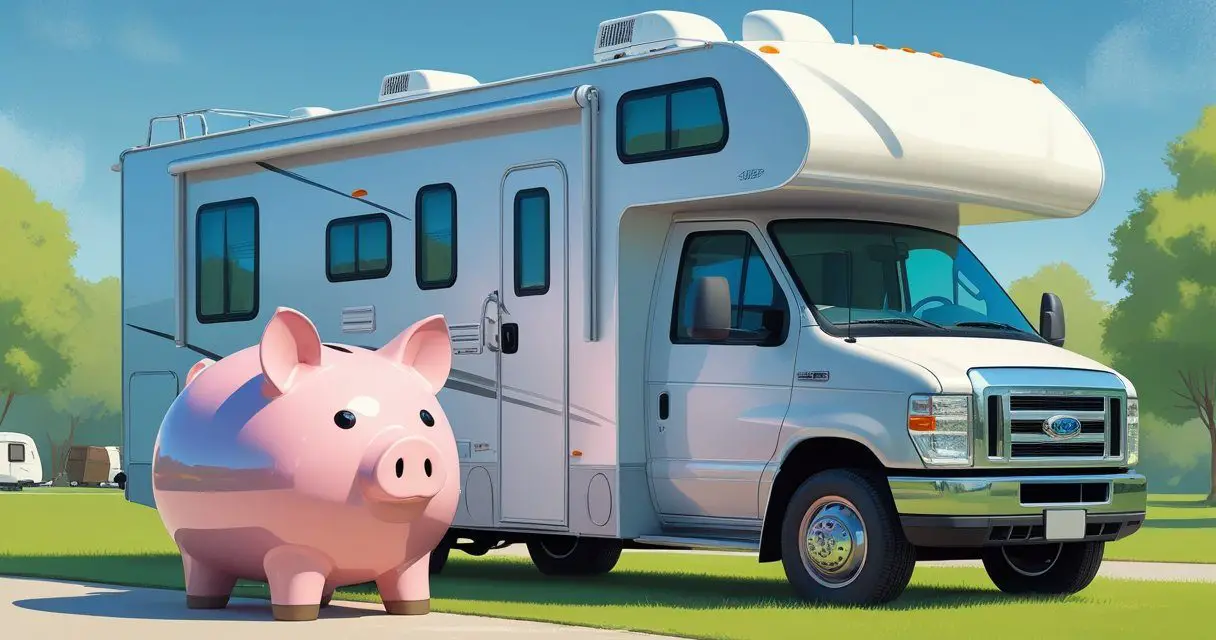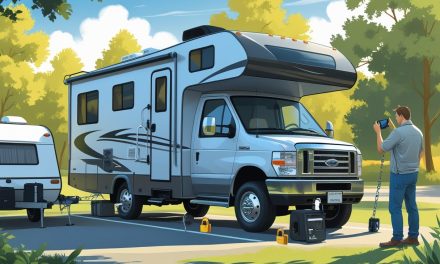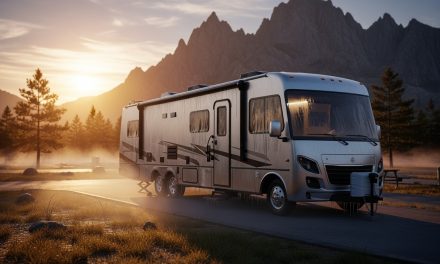Would you like to save this article?
You’ve been told a lie by fancy RV dealerships with their glossy brochures and million-dollar showrooms. They want you to believe that reliable motor homes cost $50,000, $60,000, or even $100,000. But here’s the truth that’ll save you a fortune: the toughest RVs ever built are old, affordable, and still cruising America’s highways decades after they rolled off the assembly line.
These vintage warriors were built when gas was under a buck, steel was actually thick, and manufacturers cared more about durability than touchscreen panels. New RVs lose 20-30% of their value the moment they leave the lot, but these classics have already taken their depreciation hit and are now worth their weight in road-trip gold. According to Progressive Insurance, new RVs continue losing 5-10% value per year for the first five years.
Meanwhile, these vintage gems just keep running. You can snag battle-tested road warriors for under $10,000 that will outlast their modern counterparts. They don’t come with Bluetooth speakers or LED mood lighting, but they come with something better: engines that won’t quit and frames built like tanks.
The average RV lifespan is around 200,000 miles, but many of these classics blow past that number without breaking a sweat. Let’s dive into ten vintage RVs that prove older is better, cheaper is smarter, and you don’t need a second mortgage to hit the open road.
1. Dodge Xplorer Van: The Fiberglass Phoenix That Refuses to Leak
Years Produced: 1970s-1980s | Typical Price Range: $5,000-$9,500
The Dodge Xplorer Van stands as one of the most resilient camper vans ever engineered. Designed by Ray Frank—the same genius behind the legendary Travco—this compact beast combined the bulletproof Dodge B-series chassis with a molded fiberglass roof that laughed in the face of water damage. While other vans from this era are rotting from roof leaks, the Xplorer keeps its interior bone-dry.
Inside, you’ll find everything you need and nothing you don’t: a propane stove, compact sink, convertible beds, and smartly designed storage. The layout is simple but efficient, perfect for extended travel without the unnecessary bulk. Under the hood, Dodge’s legendary slant-6 or V8 engines deliver mechanical simplicity that any shade-tree mechanic can maintain.
| Feature | Specification |
|---|---|
| Engine Options | Dodge Slant-6 or V8 |
| Standout Feature | Molded fiberglass roof (leak-resistant) |
| Parts Availability | Excellent – Dodge parts readily available |
| Maintenance Difficulty | Easy – No complex electronics |
Why This Rig Laughs at Modern Vans: While newer vans rely on fragile electronics and sensors that cost hundreds to replace, the Xplorer keeps it old-school. You won’t find yourself stranded because a $800 computer module failed. These vans are becoming harder to find in clean condition, but patience pays off.
The Reality Check: You’ll get zero WiFi hotspots and no backup cameras in this rig, but you also won’t need a computer science degree to diagnose problems. When your neighbor’s $75,000 Sprinter van is at the dealership waiting for a part from Germany, you’ll be cruising down Route 66 with a $40 carburetor fix from AutoZone.
2. Ford Econoline Coachmen Conversion: The Blue-Collar Hero
Years Produced: 1970s-1980s | Typical Price Range: $4,000-$9,000
The Ford Econoline Coachmen conversion is what happens when America’s most reliable work van platform meets practical RV design. Built on the rock-solid Ford E-series chassis, these Class B and compact Class C motor homes were designed for real families taking real trips, not Instagram influencers posing for photos.
Coachmen took Ford’s incredibly reliable van chassis and transformed it into a home on wheels that could handle cross-country adventures, heavy loads, and years of hard use. Most models came equipped with a V8 engine and bulletproof drivetrain that shrugged off mile after mile without complaint.
Inside, you’ll find fold-out beds, a small propane kitchen, a dinette, and built-in storage throughout. Some models even included a wet bath, giving you full self-contained functionality. According to RV forums on Good Sam Community, well-maintained older Class C RVs can reliably handle cross-country trips with proper tire maintenance.
Parts Availability: A Mechanic’s Dream
The E-series chassis means you can find parts at nearly every corner of the country. Whether you’re in rural Montana or downtown Miami, any Ford mechanic can work on this beast. That’s the beauty of building on a commercial platform—parts are everywhere and cheap.
The Reality Check: Sure, the interior might look like your grandma’s kitchen from 1982, complete with harvest gold appliances and wood paneling. But while your buddy with the new Class C is crying over a $3,000 repair bill for a proprietary slide-out mechanism, you’re fixing your rig with Ford parts that cost less than dinner for two.
3. Chevy G30 Champion TransVan: The Boxy Oddball That Just Won’t Quit
Years Produced: 1970s-early 1980s | Typical Price Range: $3,500-$8,500
The Chevy G30 Champion TransVan is quirky, boxy, and absolutely indestructible. Built on the proven Chevrolet G30 1-ton van chassis, this oddball combined rugged truck mechanics with a molded fiberglass shell that provides excellent durability and insulation. While most RVs from this era used aluminum siding that dents if you look at it wrong, the TransVan’s fiberglass body resists rot and leaks like a champ.
Champion was better known for mobile homes, and they brought that construction know-how to this compact motor home. The squared shape provided more usable interior space than rounded designs, and the fiberglass construction means these rigs often look better than aluminum-sided units twice as young.
| Component | Advantage |
|---|---|
| Body Construction | Fiberglass (no rot, fewer leaks) |
| Chassis | Chevy G30 1-ton (heavy-duty) |
| Engine | Small-block V8 (300,000+ mile potential) |
| Interior Space | Boxy design = more usable room |
Under the hood, the G30 usually came with a Chevrolet small-block V8—an engine so legendary it powered everything from muscle cars to delivery trucks. Mechanics across America know this engine inside and out, and parts are cheap and plentiful. You can still locate decent TransVans under $10,000, and many only need minor updates to get back on the road.
The Reality Check: Let’s be honest: this thing looks like a moving brick. Your neighbors might wonder if you’re living in an industrial refrigerator. But while their sleek modern RV is in the shop with delamination issues, your fiberglass fortress is still rolling strong, completely unbothered by water damage or panel separation.
4. Toyota Dolphin: The Import That Shamed American Reliability
Years Produced: 1980s-1990s | Typical Price Range: $6,000-$12,000 (sometimes over budget, but worth it)
The Toyota Dolphin became one of the most beloved small motor homes of the 1980s because it did something American RVs couldn’t: it combined legendary Toyota reliability with actual fuel efficiency. Built on the Toyota pickup chassis with a coach body by National RV, the Dolphin offered surprisingly spacious interiors without the bulk of full-size Class Cs.
According to The Rolling Pack, it’s not uncommon for Toyota motorhomes to run well over 200,000 miles on the original engine. The legendary 22R and 22RE engines are so reliable that many owners report 150,000 miles as just “getting broken in,” per discussions on ToyotaMotorHome.org.
Most Dolphins featured a four-cylinder or V6 engine that delivered exceptional longevity and fuel mileage between 14-20 MPG—numbers that make modern Class Cs weep with envy. The layout includes a convertible dinette, overhead cab bunk, compact propane kitchen, and a small but usable wet bath.
The Cult Following That Keeps Values Up
The Dolphin’s popularity means parts and community knowledge are still abundant. Online forums are packed with owners sharing tips, tricks, and maintenance guides. While clean examples are starting to rise in price (sometimes exceeding $10k), it’s still possible to find project Dolphins under budget if you’re willing to do minor repairs.
The Reality Check: The four-cylinder engine means you won’t be winning any drag races or climbing mountains at highway speeds. You’ll be that person puttering up Pikes Peak at 35 mph with a line of cars behind you. But when everyone else is filling up their tanks twice as often, you’ll be laughing all the way to the next national park.
5. Winnebago Brave (Early 1970s Models): The Iconic American Dream Machine
Years Produced: Early 1970s | Typical Price Range: $4,500-$9,500
The early 1970s Winnebago Brave stands as one of the most iconic American motor homes ever produced. Its boxy silhouette and bold side stripes became a staple of road trips across the country during the golden era of RV travel. Built on a sturdy Dodge chassis with a V8 engine, the Brave featured robust drivetrain components that prioritized simplicity and serviceability.
What set the Brave apart was its no-frills durability. The cabinetry, fixtures, and mechanical systems were built with longevity in mind—more substance than style. According to discussions on Reddit’s RV community, RVs from “the old days” that are still on the road were genuinely better made than many modern units.
| Era | Construction Quality | Modern Equivalent Value |
|---|---|---|
| Early 1970s Brave | Thick steel, solid wood, durable fixtures | $4,500-$9,500 |
| Modern Budget Class C | Thin aluminum, particle board, plastic | $50,000-$80,000 |
Inside, the Brave offered all the essentials: convertible dinette, overhead bunk, small propane-powered kitchen, and compact bathroom. Many of these rigs, despite being 50+ years old, are still operational today thanks to their strong frames and easily repairable systems.
The Reality Check: You’ll be driving something that looks like it escaped from a 1970s postcard. The harvest gold interior, shag carpeting, and wood paneling scream “groovy, baby!” If retro isn’t your style, you might feel like you’re living in a time capsule. But that time capsule has outlasted three generations of “modern” RVs and is still ready to roll.
6. GMC Vandura Camper Conversions: The A-Team Van’s Practical Cousin
Years Produced: 1980s | Typical Price Range: $3,000-$8,000
The GMC Vandura became the backbone of 1980s van culture and countless camper conversions thanks to its rugged platform, simple mechanics, and boxy design that offered generous interior space. Whether converted by companies like Starcraft and Explorer, or by creative DIYers, the Vandura was built to last.
With a V8 engine under the hood and a heavy-duty frame, this van handled weight and distance with ease. Inside, camper conversions varied wildly, but often included a propane stove, small sink, fold-down couch or bed, and custom cabinetry. Some even featured pop-tops or high-roof fiberglass caps for added headroom.
Mechanical Simplicity Is Beautiful
What makes the Vandura shine today is its mechanical simplicity and parts availability. Built on GM’s well-known platform, nearly every component is still easy to replace or upgrade without draining your wallet. Whether you’re after a stealth camper for urban adventures or something nostalgic and functional, these rigs are still out there for under $10,000.
The Vandura remains a favorite among budget-minded travelers who want an affordable camper that doesn’t quit. Its solid bones, workhorse engine, and customizable layout make it a smart choice for anyone seeking old-school reliability on the road.
The Reality Check: You’ll essentially be camping in a windowless work van with a bed in the back. Good luck explaining to your significant other why you’re suggesting a “romantic getaway” in what looks like a plumber’s work vehicle. But hey, when you’re parked at a scenic overlook and haven’t spent $60,000 on depreciation, suddenly that van looks pretty romantic.
7. Shasta Compact Class C (1970s-1980s): The Middle-Class Hero
Years Produced: 1970s-1980s | Typical Price Range: $3,500-$7,500
Shasta is often associated with vintage travel trailers, but its Class C motor homes from the 1970s and 1980s deserve equal attention. Built on reliable van chassis from Dodge, Ford, and Chevrolet, these rigs combined affordable construction with efficient interior layouts designed for middle-class families who wanted road trip freedom without sacrificing their savings.
Inside, Shasta Class Cs featured all the essentials: propane stoves, refrigerators, convertible dinettes, overhead bunks, and compact wet baths. Despite their small size (most units under 25 feet), the layouts were intelligently arranged to maximize every square foot. This makes them easier to drive and park than modern 30-foot behemoths.
What gives Shasta an edge is its lightweight build and mechanical simplicity. With a bit of upkeep and minor upgrades, these older models can still offer dependable travel experiences today. They’re among the most budget-friendly vintage rigs out there, with many still found under the $10,000 mark, especially if you’re open to light renovation.
The Reality Check: The interior will look like a 1978 mobile home had a baby with a camper—because that’s essentially what it is. You’ll have tiny windows, low ceilings, and décor that makes your local thrift store look cutting-edge. But while luxury Class C owners are dealing with slide-out failures and expensive computerized systems, you’re cruising with simple systems that actually work.
8. Dodge Sportsman Class C: The Workhorse Nobody Remembers
Years Produced: 1970s-early 1980s | Typical Price Range: $3,000-$8,000
The Dodge Sportsman Class C was a genuine workhorse of the 1970s and early 1980s, serving as the foundation for many popular motor home brands. Built on the rugged Dodge Sportsman van chassis, these motor homes were known for their durability, mechanical simplicity, and ease of repair.
Powered by dependable V8 engines like the 360 or 440, the drivetrain was straightforward and parts were widely available across the country. This platform became the base for several coach builders who outfitted the rigs with compact kitchens, overhead cabs, convertible dinettes, and wet baths—everything needed for self-contained travel.
| Advantage | Why It Matters |
|---|---|
| Dodge V8 Engines | Parts available nationwide, easy repairs |
| Simple Systems | No specialized tools needed for maintenance |
| Coach Builder Variety | Multiple brands used this chassis (more options) |
| Structural Toughness | Heavy-duty van frame handles road stress |
One of the biggest advantages of Sportsman-based RVs is their structural toughness and the ability to perform regular maintenance without specialized tools. For budget-conscious buyers, this means fewer surprises and lower repair costs. Even decades later, these rigs can still be found cruising highways or tucked into national parks.
The Reality Check: You’re basically driving a giant metal box on a van frame. The aerodynamics rival a brick wall, so expect to feel every crosswind on the highway. You’ll white-knuckle it through windy days while gripping that oversized steering wheel like your life depends on it. But when modern RVs are sidelined by electronic failures, your purely mechanical Sportsman just keeps on trucking.
9. Ford Tioga by Fleetwood (Early 1980s): The Family Favorite
Years Produced: Early 1980s | Typical Price Range: $5,000-$9,500
The early 1980s Ford Tioga by Fleetwood became one of the most recognizable Class C motor homes in America, largely due to its perfect blend of affordability, durability, and family-friendly design. Built on the Ford Econoline chassis with V8 engines and a tough frame, the Tioga could handle long-distance travel and heavy use without complaint.
Fleetwood added practical interiors that catered to everyday needs: overhead cab beds, convertible dinettes, compact propane kitchens, and bathrooms with toilets and showers. The layouts were simple but highly functional, maximizing space without unnecessary extras.
Mechanically, the Tioga benefited from Ford’s extensive parts network, making repairs affordable and widely accessible. These rigs were built during a time when RV manufacturers prioritized function over flash, which is why so many are still on the road today. According to the Curbside Classic blog, the RV industry had a massive boom from 1977-1980 before the energy crisis, and Tiogas from this era represent that peak period of production quality.
The Reality Check: The Tioga’s popularity means everyone and their grandma had one, so you won’t win any originality awards at RV rallies. It’s the Honda Civic of vintage Class Cs—boring, predictable, and absolutely everywhere. But like the Civic, it just refuses to die, and that boring reliability beats exciting breakdowns every single time.
10. Holiday Rambler Alumalite (1980s Models): The Ahead-of-Its-Time Wonder
Years Produced: 1980s | Typical Price Range: $5,500-$10,000
The Holiday Rambler Alumalite motor homes from the 1980s were ahead of their time in both construction and design. Known for their lightweight yet durable aluminum framing, these rigs stood out in an era dominated by wood-framed coaches prone to rot and water damage.
The Alumalite’s use of laminated sidewalls and sturdy build quality helped it resist the wear and tear that has sidelined many of its contemporaries. Built on solid Ford or Chevy van chassis, they came equipped with V8 engines that were simple to maintain and well-supported by national parts availability.
| Construction Element | Holiday Rambler Alumalite | Standard 1980s RV |
|---|---|---|
| Frame Material | Aluminum (rust-resistant) | Wood (rot-prone) |
| Wall Construction | Laminated sidewalls | Standard aluminum siding |
| Longevity | Many still running strong | Most decomposed by now |
Inside, Alumalite models offered functional floor plans with fully equipped kitchens, convertible dinettes, and compact bathrooms. While the décor was classic 1980s, the craftsmanship and layout continue to impress even today. These motor homes were designed to last, and many owners still proudly operate theirs decades later.
Prices vary by condition, but it’s not uncommon to find usable examples under the $10,000 mark, especially with original interiors. For anyone seeking a structurally sound, road-ready RV with vintage charm and modern bones, the Holiday Rambler Alumalite delivers.
The Reality Check: While the aluminum frame won’t rot, the 1980s interior definitely will assault your senses. Picture mauve upholstery, teal accents, and geometric patterns that could trigger seizures. It’s like living inside a Miami Vice episode. But that indestructible aluminum construction means this rig will still be rolling when modern particle-board RVs have decomposed into sawdust.
Why These Vintage Warriors Beat Modern RVs
Here’s what RV dealers will never tell you: new RVs are designed to be sold, not to last. According to Progressive, new RVs lose 20-30% of their value in the first year alone. Meanwhile, these vintage rigs have already taken their depreciation hit and often increase in value as they become collectibles.
Modern RVs are filled with proprietary parts that cost a fortune to replace. These vintage warriors use standard automotive components you can find at any parts store. When something breaks, you fix it with common tools and affordable parts—not a $2,000 computer module that requires a dealer technician.
The Bottom Line: You don’t need $50,000 to hit the open road with confidence. These ten battle-tested RVs prove that strength, reliability, and adventure don’t come with a massive price tag. They come with thick steel, simple engines, and a legacy of outlasting everything the modern RV industry produces.
Conclusion: Your Next Adventure Awaits (And It Costs Less Than a Used Car)
The RV industry has spent decades convincing you that reliable motor homes require massive investments. But now you know the truth: the toughest RVs ever built are hiding in classified ads, auction sites, and backyard sales for under $10,000.
These vintage warriors—from the leak-proof Dodge Xplorer to the unstoppable Toyota Dolphin—were built in an era when durability mattered more than touchscreen panels. They don’t have WiFi boosters or solar panel packages, but they have something far more valuable: engines that run forever and systems you can actually fix yourself.
So grab your toolbox, start searching those classifieds, and prepare for adventures that won’t break the bank. The open road is waiting, and your next vintage RV is out there, ready to prove that old school reliability beats modern complexity every single time.
SOURCES
- 10 RVs Under $10,000 That Will OUTLAST Everything – Road Life Guide (YouTube)
- How Does RV Depreciation Work? – Progressive Insurance
- Reliability of Older Class C’s – Good Sam Community
- Is There Truth to the Idea That Older RVs Were Built Better? – Reddit
- Why We Chose a Toyota Motorhome – The Rolling Pack
- How Many Miles Does Your Dolphin Have? – ToyotaMotorHome.org Forums
- Two Old Dodge Motorhomes – A Study In Contrasts – Curbside Classic
- How Long Do RVs Last: Lifespan of RV Classes – RVshare
- Which RVs Hold Their Value – Lazydays RV
- GMC Motorhomes: True Blasts From the Past – RV.com
- Pros and Cons of Vintage RVs – Camping World Blog





